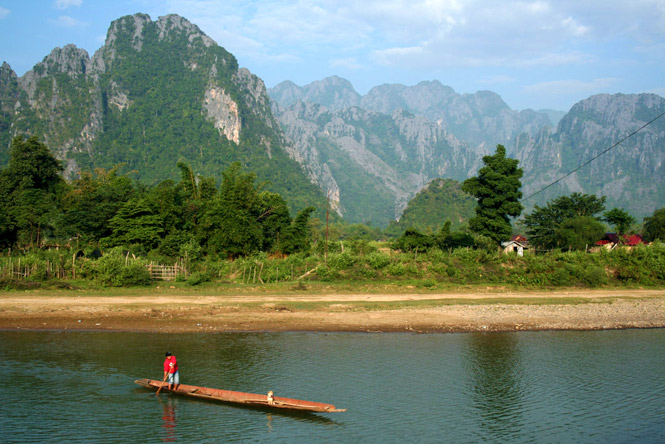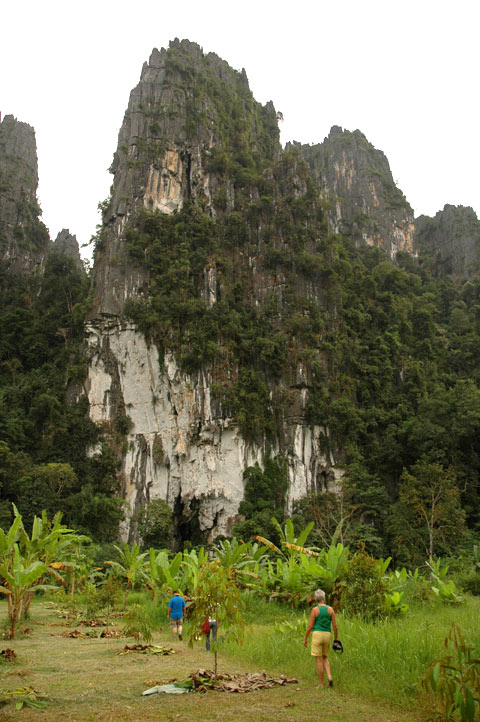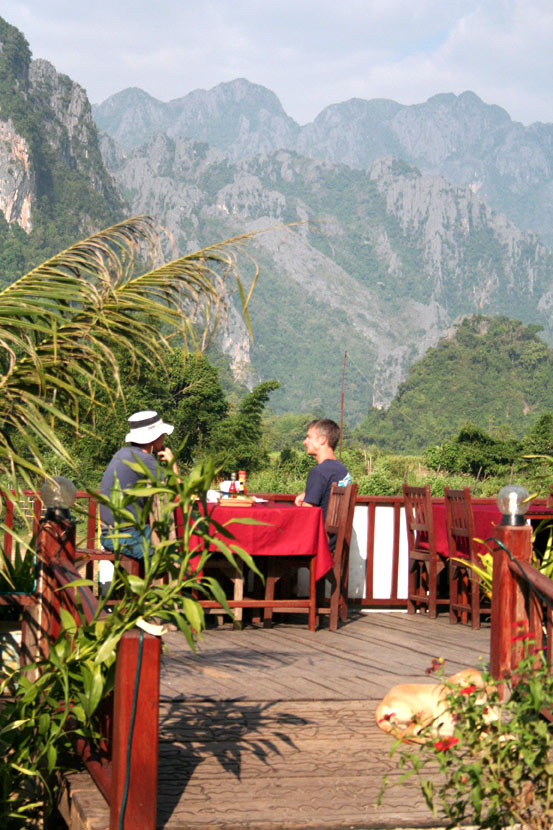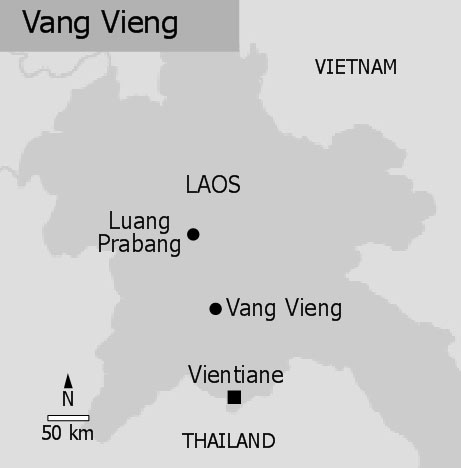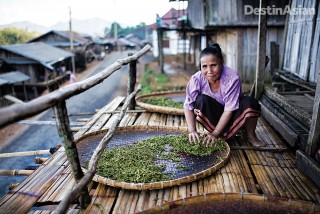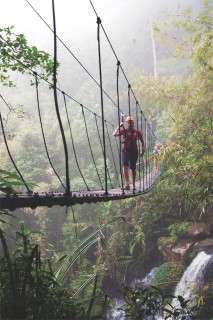Above: Limestone hills frame the Song River as it flows through Vang Vieng.
The Lao town of Vang Vieng offers more than just a stop on the backpacker circuit.
By Charles Foran
Photographs by Joanna Smith
At Mr. T’s Organic Farm, a sign posted in English notes that in Laos, kissing and hugging in public is impolite. Another simply says: please be discreet. These admonishments aren’t meant to drive visitors away. Quite the opposite. Set on the banks of the Song River just north of Vang Vieng, the two-hectare mulberry farm has a guesthouse and a restaurant. Travelers can rent rooms, eat locally grown food, and even volunteer to help teach children some English. The sixtysomething Thanongsi Solangkoun, a.k.a. Mr. T, is committed to improving life in these mountains.
On the afternoon I chat with Mrs. T about the handwoven scarves for sale in the restaurant—her husband is away overseeing his latest project, a bus service to transport children from outlying villages to the elementary school he has set up—the air has a pulse. Or so 120 decibels of music blasted outdoors registers from a quarter-kilometer away. Finding the source of the throb is as easy as following the Song downstream to the rope-swing towers and bars on either riverbank. Some 200 Westerners in swimsuits and tattoos crowd the platforms and decks. Few are older than 30, and some appear too young to be imbibing the buckets of rice whiskey and bottles of Beerlao on sale. Drink they do, however, often in advance of climbing 10 meters to swing from ropes and plunge into the shallow water. Others set off for the lazy drift south into town, using rented inner tubes or floats of their own making. A blaring, globalized soundtrack—U2, M.I.A., Lily Allen —renders the scene a surreal cross between the U.S.O. show in Apocalypse Now and any film starring Will Ferrell as a superannuated undergraduate.
Welcome to Vang Vieng—or rather, welcome to the wrong end of it. For two days I have been mentally sketching a map of this strange place. Right now, the town of 30,000 is known mostly as the setting for a boisterous rite of passage—tubing and kayaking, drinking and maybe getting high—for Western backpackers on extended tours of Southeast Asia. More an excuse for young travelers to party with each other, this scene has come to define Vang Vieng. Lost, by and large, has been the surrounding landscape: limestone hills honeycombed with caves; spring-fed lagoons and slow-running rivers; rice paddies and stilted villages. A more serene, timeless dream of tropical Asia could scarcely be imagined.
Geography has definitely played a role in the town’s destiny. Vang Vieng nestles among the mountains that rise up through central Laos. Vientiane, the Lao capital, is four hours by road to the south; Luang Prabang, the World Heritage–listed city, is a seven-hour drive farther north. With no airport or train tracks, Vang Vieng is reachable only by road—by bus, in effect, except for seasoned bicyclists, like the young Israeli I spot inquiring about a room at Mr. T’s. Being situated near the halfway mark of a grueling bus ride triggered the “discovery” of the town in the 1990s by the earliest waves of backpackers admitted into the country, which had been isolated since the Communist victory in 1975. Ravers, scouring the region for sites to hold their full-moon parties, soon fell upon it as well.
In 1994 there were just two guesthouses, with a single generator providing power a few hours a day. By the end of the decade a hasty infrastructure of cheap places to stay and eat and fun things to do had sprouted up. That nearly everyone who made it to Vang Vieng in the early days was shoe-stringing his or her way through Laos determined the form the tourism industry took. The kids wanted to tube the river and go wild at full-moon parties. They wanted to watch movies and eat submarine sandwiches. Some, too, wanted to get a buzz on from fruit shakes laced with psychedelic mushrooms and marijuana. Unfortunately, the availability of harder drugs like opium occasioned a third stratum of foreigner, a sordid subculture of addicts labeled the “Zombies.”
A 2001 story in the Asian edition of Time magazine exploring that side of Vang Vieng led to a government crackdown, but within a couple of years the town had its swagger back. It is now bigger and louder than ever, though Zombies appear a tiny minority. The main drag is crammed with Internet cafés and guesthouses, beer bars and open-air restaurants where backpackers repose atop pillow-covered couches in order to bliss out to multiple episodes of Friends. The loop runs from early morning till past midnight, and the laugh track carries especially far. When I ask a waitress how she stands the sitcom chatter all day, she explains that her limited English spares her the pain.
But south of this miniature version of Bangkok’s Khaosan Road lies a whole other town. This Vang Vieng runs along the east bank of the Song River as well, and is where the majority of Laotians, along with their hospital and schools, can be found. At sunrise, dogs must be shooed from the road, where they have lounged all night. Children wander down to the river to bathe before donning school uniforms. After sunset, the darkness and silence are country deep, although sometimes that same throb drifts down the Song from the bacchanal to the north.
One of the first guesthouses to open here, the eight-year-old Maylan, is actually located in a village across a bridge near the high school. From there, lagoons and caves housing Buddhas are a short walk away. One of the newest hotels, the elegant Elephant Crossing, looks out at the Maylan from the town side of the river. It boasts a view of those caves and hills that makes sitting on a balcony at sunrise or sunset better than any drug.
Rachel Dechaineux owns and manages the Elephant Crossing with her Lao husband Samphan. The Australian, whose two young children play in the lobby and garden most days, first came to the country as a language student in the 1990s. She witnessed Vang Vieng during its one-generator era, and watched, largely from Vientiane, as it bloated —unchecked and unsupervised—into a backpacker haven. The couple bought the land in 2000 but resolved to wait until the town seemed ready for a better breed of accommodation. “Flashpackers” is how she labels her guests, inferring a more mature and affluent solo traveler; although on the nights I stay at the Elephant Crossing many of the rooms are occupied by elderly Thais on a group trip. Whether due to mainstream tourists or simply backpackers seeking more authentic experiences, adventure companies are lately finding a clientele for all-day kayaking, trekking, caving, and rock-climbing excursions. None of these outings into the glorious countryside involves whiskey buckets or mushroom shakes.
A more dignified tourist destination seems to be evolving, and though inhibited as much by isolation as reputation, it may one day eclipse its louche counterpart. Near the highway is an abandoned runway, built by the Americans during the Vietnam War to help them bomb other parts of Laos. There is talk of a charter company running flights in from Vientiane.
At the far south end of town is a footbridge leading to Tham Chang—the most famous of the local caves—and to a popular lagoon. Late one afternoon, with the heat still intense, I cross the bridge for a swim. Four young German men in shorts and T-shirts are hesitating by the water. Asked why they aren’t already in, they confess to being unsure whether it is appropriate to strip down to swimsuits so close to the Buddhist shrine at the cave entrance.
As we are debating the matter, a gaggle of local boys wearing only shorts slip past us and are quickly laughing and splashing in the lagoon. With the matter resolved, the cool blue waters soon welcome everyone.
THE DETAILS:
Vang Vieng
Getting There
Vang Vieng is situated about 160 kilometers north of Vientiane along Highway 13, a four-hour drive by bus or private vehicle. Transportation can be arranged through Green Discovery Laos (856-21/264-528; greendiscoverylaos.com), an adventure outfitter that also organizes trekking, rafting, and cycling tours.
Where to Stay
Escape the backpacker crush at the Elephant Crossing Hotel (856-23/511-232; theelephantcrossinghotel.com; doubles from US$45), where 31 comfortable rooms feature wooden floors and balconies overlooking a pretty stretch of the Song River.
Where to Eat
For fresh local fare, head three kilometers north of town to Mr. T’s Vangvieng Organic Farm (Phoudindaeng; 856-23/511-220; laofarm.org). The restaurant here serves imaginative Lao cuisine and homemade mulberry wine in a peaceful setting that trumps any of the cafés and bars littering Vang Vieng’s main drag. While there, stock up on the farm’s organic teas and fruit liqueurs, which are sold alongside silk scarves woven by the women of Phoudindaeng village.
Originally appeared in the February/March 2010 print issue of DestinAsian magazine ( “Changing Currents”)

